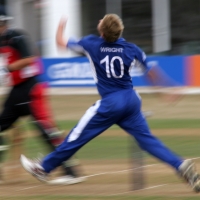5 Ways to Bowl with Express Pace
 Jarred Opperman was on a path to fast bowling glory. He was in the Natal team, and the speed gun was showing the high 130s. He took pride in knowing that the batsmen were afraid of his speed.
Jarred Opperman was on a path to fast bowling glory. He was in the Natal team, and the speed gun was showing the high 130s. He took pride in knowing that the batsmen were afraid of his speed.
“There is no better feeling in the world. The battle is already half over.”
He told me when we caught up over Skype recently. So why isn't Jarred the next Brett Lee? What happened to stop him becoming an international superstar?
It wasn't anything to do with his talent, his pace or his accuracy. It was the one word all quick bowler's fear;
Injury
Thanks to a stress fracture at 18, Jarred had to retire. At the time, there was no fast bowling coaching that was aware of injury prevention. Coaches were told not to “tinker” and the left Jarred alone with a natural action that was doomed to fail him.
The new rules of fast bowling
This set Jarred on a mission. The young man had lost one passion, but he gained another: To stay in the game and help other bowlers reach their potential for pace.
He turned to coaching fast bowlers, learning the lessons from his own short career, he soaked up ideas from innovators like Ian Pont and Steffan Jones. He started coaching bowlers to be fast, accurate and - most importantly - injury-free.
Back to the present day, and Jarred has learned plenty about express pace. As we spoke, he revealed 7 of his methods to ramp up pace without breaking your back. Methods he has used to great success with the young players that he has coached.
1. Tinker with confidence
A natural action is not always the best action. If your “natural” technique inclines you to injury then you will end up broken. You can't take wickets with a stress fracture.
So, be prepared to compare yourself to a template that works. The 4 Tent Pegs is the place to start.
Work out where you can improve, then spend time “reverse chaining” until the movement feels natural and gets you closer to the template.
This is not about becoming a robotic bowler with an unnatural action. It's about learning what movements work best for your body. This is where a good bowling coach like Jarred can make a huge difference. He is an extra pair of eyes with experience. He can show you how to drill, for example, a back foot drag that indicates a powerful action.
This takes time. Some people take one session, others take months. But there is no shortcut.
Persist along the right path, and you will be rewarded.
2. Video is vital
Jarred video's every coaching session because video provides crucial feedback. There is nothing like seeing yourself to quickly understand your action.
When you have video of yourself, you can instantly see things externally that you only feel before. This takes your technical game to a new level. It provides a feedback loop that is one of the secrets of deliberate practice.
You can use PV/VIDEO, a video camera or even an iPhone, but use something if you are serious about making positive technical change.
3. Avoid props
Video might be vital, but too many cones and poles are counter-productive.
The closer to a game you can make practice, the better, so that means leaving the external guides behind. You see many coaches using cones to show run ups, follow-throughs, ,target areas on the pitch and so on. While there is a place for that, the more you use external guides the less you are self-reliant in a match.
Use the guides like stabilizers on a bike. Start there to stop yourself falling off, but once you know how to ride, throw the stabilizers in the bin.
4. Pace is strength
You have to be strong to be a fast bowler. You can't have power or speed without strength as a base. That's where strength and conditioning comes in.
But fitness is not a separate component of your fast bowling speed plan. You must understand how S&C crosses over to cricket. That means having a basic understanding of the fundamentals of athletic training and putting them into your practice sessions.
This is about quality of movement, recovery, mobility, coordination and strength. It's easy to achieve these things, even if you are under 18, but if you passion is to bowl fast you must learn how the two world integrate together.
It's no longer enough to do a few crunches for core training, run a couple of miles for endurance and then bowl.
5. Be simple, but not too simple
We can all improve pace, but everyone has limits. Most people cannot achieve 90mph. However, you can work on the simple things that have the greatest effect.
So, get really good at the basics (like the 4 tent pegs), it will take longer than you think, and avoid over-thinking. That way you will avoid jumping around different methods and stay focused on that ultimate prize.
Overall, you can learn from Jarred's experiences. He has had the pain of injury and loss of a cricketing career. He has had the joy of ramping up young bowlers pace and this article has given you some practical steps you can take to your next session.
Jarred Opperman originates from Durban, South Africa where he represented Kwa-Zulu Natal High Schools. He is now a Pace Bowling specific coach based in England. He specialises in developing pace, safe bowling actions in bowlers, as well as improving tactical performance.
- Login to post comments

